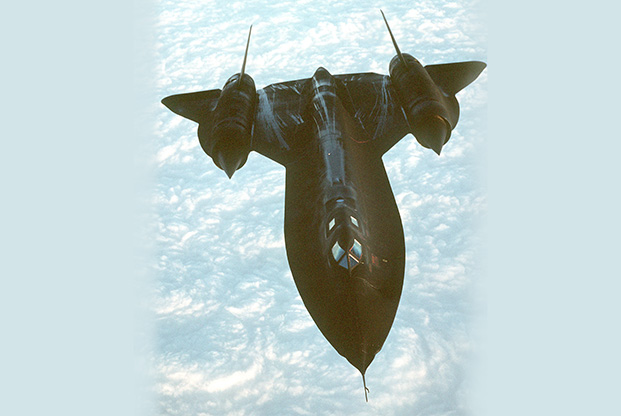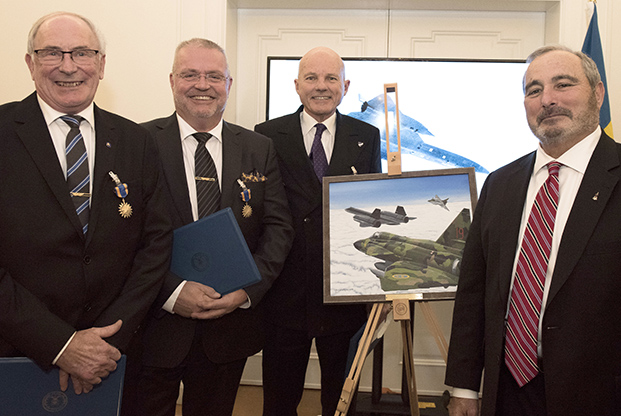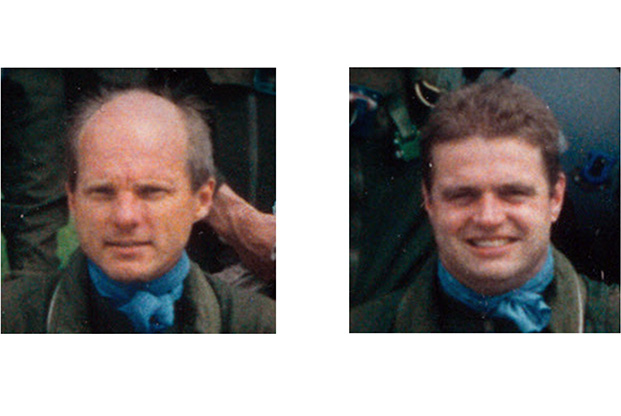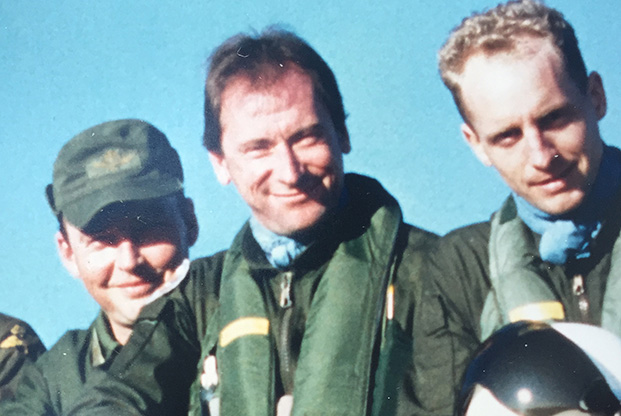
An SR-71 from RAF Mildenhall, UK, in 1988. The supersonic jets were prone to engine troubles. Photo: SSgt. David Nolan
The US Air Force doesn’t typically award air medals to pilots from neutral countries for assisting in combat missions, but in November it did: Four former Swedish Air Force pilots were presented the awards in a Stockholm ceremony, spotlighting an incident that had been a Cold War secret for 31 years.
On June 29, 1987, during a routine flight to surveil Soviet activities in the Baltic Sea, a US Air Force SR-71 Blackbird—a triple-sonic, super-secret spyplane—blew one of its two engines. The crew instantly recognized they were in serious trouble; the spyplane’s high operating altitude and extreme speed were its only defenses. Down an engine and near Soviet airspace, they could still fly, but had to descend in speed and altitude.
Now Soviet aircraft could reach and catch them.
The Blackbird risked being shot down or forced to land, its crew moments away from capture, the frigid waters of the Baltic, or even death.
Lt. Col. Tom Veltri, now long retired, was in the back seat. Copilot Lt. Col. Duane Noll was in the front. “We were … three seconds from our turn point,” Veltri said. He recalls this with certainty because he was counting the seconds down “in case the airplane didn’t turn itself, because otherwise we’re going to go right over sovereign [Soviet] airspace.”
“I’m counting down ‘5, 4,’ and the right engine explodes,” he recalled.
Then the left engine had to adjust to the loss of the right engine—called an unstart—to ensure the jet remained under control, Veltri explained. Without that, “the supersonic air comes around the compressors” and there would have been insufficient rudder authority to handle the aircraft’s asymmetric “tricks and thrust.”
Blackbirds couldn’t fly Mach 3 at 80,000 feet on a single engine, and speed wasn’t their only problem. The engine explosion shut off the aircraft’s generators, causing the cabin to lose pressure and triggering the full inflation of both pilots’ pressure suits, making it hard to move around and keep the aircraft airborne.
The aircraft plunged, dropping 40,000 feet in one minute. At half the usual cruising altitude, it became safe to make a southward turn, so Veltri and Noll decided to head toward the Baltic island of Gotland—Swedish territory—where they might land.
“We knew that they were gonna treat us better than the Soviets,” he said.
Veltri also decided to expose the aircraft to air-traffic control by switching on squawk. While this wasn’t standard procedure—it made the jet easily visible to the Soviet air force—Veltri called it “probably the best thing I ever did that day.”
Though its speed, altitude, and reduced radar cross section made the Blackbird great at sneaking into an area, its distinct sonic boom and the massive infrared signature of its engines made a stealthy exit nearly impossible.
“Come on, who are we fooling at this point?” he thought. “Let’s hope the … cavalry comes before the bad guys.”
They leveled the aircraft at 25,000 feet and an airspeed of about 380 knots, hoping they could make it to a safe airfield, because there wasn’t enough fuel to get back to RAF Mildenhall, UK, nor enough time to connect with an aerial tanker, Veltri said.
Then, he spotted two dots approaching from the east—the direction of the Soviet Union—through his left window.
The two pilots decided they would “point the nose down and bail out” if they saw a missile “coming off the rail” of a pursuing jet.
“Not the greatest plan in the world,” Veltri admitted, but his options were few.
But as the dots got closer, he realized they were not Russian jets, but Swedish Viggen fighters.

Left to right: Retired Swedish Air Force members, Col. Lars-Eric Blad, Maj. Roger Möller, and Maj. Krister Sjöber, wearing US Air Medals, and retired USAF Lt. Col. Tom Veltri with a painting depicting the Swede’s daring action. Photo: SrA. Kelly O’ Connor
The Viggen pilots had been on a training mission when their controllers asked them to check out the SR-71, identify it, and evaluate whether it was a threat.
Recalling the incident in a phone interview, retired Swedish Air Force Maj. Krister Sjöber said he could hear tension in the controller’s voice when he got that call, so he knew something unusual was up. As they kept flying east, the controller informed Sjöber and the other Viggen pilot, retired Swedish Air Force Maj. Roger Möller, that the aircraft in question was a Blackbird, “and that it had violated Swedish airspace and … was low level at this time.”
Although the Americans didn’t know it, their repetitive and predictable pattern of flights across the Baltic was well-known to the Swedes, who’d nicknamed it “the Baltic Express,” and the Flygvapnet used them as training opportunities.
“We knew when they were coming,” Möller said. They “always [flew] the same path: in the South of Bornholm—a Danish island—going for the East Coast, or the eastern part of the Baltic, make a 180-[degree] turn in the northern part of [the] Baltic, and then came on the southbound, heading just between the island Öland and the island Gotland.”
The Swedes flew training intercepts “To see … are we able to have a radar lock on him, will our missiles maybe hit if we had to” shoot, Möller said.
Sjöber recalled throttling up and going supersonic once he and Möller were over water to reach the Blackbird as quickly as they could.
“Suddenly, [the Blackbird] came out of kind of a misty sky and into a clearer sky, and then he was slow and low,” Sjöber said. They immediately saw the Blackbird “was in distress.”
It was “obvious to us that he was on one engine only, so we stayed there as long as we could, basically to see that he was all right, and if he wasn’t all right—if they had to bail out—we could pinpoint the position of the pilots,” Sjöber said.

Viggen pilots and retired Majs. Krister Sjöberg, left, and Roger Möller. Photos: Retired Maj. Krister Sjöberg/courtesy
Then things got dicey. A Russian MiG-25 Foxbat pulled alongside the Viggens. Veltri would later learn that the National Security Agency, which tracks international communications, had concluded the Russian plane was under orders “to force us to land or shoot us down,” Veltri said.
The Foxbat left after a few minutes. Veltri said it was the only Russian aircraft the USAF pilots detected visually, though the NSA later informed them that “at least 20 Soviet aircraft were launched as we continued our journey past Lithuania, Poland, and East Germany.”
“We didn’t see any other Soviet aircraft, but they continued to launch, waiting for the Viggen pilots to peel off,” Veltri said. “And if they had an opening, then they were gonna be able to come in on us.”
None of the Swedish pilots interviewed by Air Force Magazine actually saw Soviet aircraft; indeed, they didn’t learn that part of the story until “this ceremony we had up in Stockholm,” Sjöber said.
When the the escort ran low on fuel, two quick-response Viggens were launched to replace the initial two jets.
“As soon as we got into the aircraft, we were ordered to scramble as fast as we could,” said retired Swedish Air Force Col. Lars-Eric Blad, one of the QRA (quick reaction alert) pilots who tag-teamed with the initial Viggens to ensure the Americans’ safety.
Since Blad and his fellow QRA pilot, now-retired Lt. Bo Ignell, were technically coming in from the wrong coast, he said, they flew over southern Sweden at Mach 0.98—just below sonic speed—then accelerated as soon as they reached water.
Blad and Ignell stayed with the Blackbird until it reached Danish territory, where American F-15s based in West Germany met and escorted the SR-71 to Nordholtz AB, Denmark, where it landed safely.

QRA pilot retired Col. Lars-Eric Blad, center, squadron commander. Photo: Retired Col. Lars-Eric Blad/courtesy
The 1987 incident was the third Blackbird engine explosion Veltri survived. In a previous incident over Cuba, his proximity to Key West, Fla., made a safe landing much simpler.
Veltri posited that the SR-71’s quick evolution from drawing board to operations may have been a factor in its susceptibility to engine failures, but he said his confidence in the aircraft was never shaken.
“I felt that I was trained to such a degree that, even if something did happen, we could handle any emergency,” Veltri said.
Over the next three decades, Veltri tried to identify and locate the Swedish pilots who came to his rescue that day.
For years after leaving the Air Force, his work as a lobbyist occasionally brought him into contact with Swedish defense professionals, with whom he’d share the story of his unknown rescuers.
“And I said, ‘Someday, I really want to find these pilots. Someday, I really owe it to them to shake their hand and thank them.’”
In 2017, he got his wish. A representative from the Saab company of Sweden at an Air Force Association conference recognized the story immediately. He was a former member of the Viggen squadron and offered to make the introduction.
Retired Air Force Lt. Gen. Charles R. Heflebower suggested the Swedish pilots be formally recognized for the mission, Veltri said. Heflebower linked Veltri up with the staff of Heidi Grant, USAF’s deputy undersecretary for international affairs. Once the details were verified, it was possible to award the Swedes US Air Medals, Veltri said.
“I can tell you for a fact they will cherish [the medals] until the day they die,” Veltri said.
Three of the four retired Swedish pilots involved received the US Air Medal in person on Nov. 28, 2018, in Stockholm. The fourth, Ignell, couldn’t attend because he was on a scientific expedition in Canada, Blad said.
The citation praised the pilots for recognizing the emergency situation and deciding to support the Blackbird “by defending it from any potential third-party aircraft that might have tried to threaten it” and for staying with the jet past Swedish boundaries to ensure its safe recovery.
Noll was unable to attend the ceremony, Veltri said, but he thanked the pilots via a video message played during the event.
“Your obvious skills and judgement were definitely demonstrated on that faithful day many years ago. I want to thank you for your actions,” Noll said.
“We will never know what would or could have happened, but because of you, there was no international incident. The US Air Force did not lose an irreplaceable aircraft, and two crew members’ lives were saved.”
Veltri savored meeting his benefactors. “It’s rare,” he said. “How many people get to say they got to meet somebody who saved their life?”
